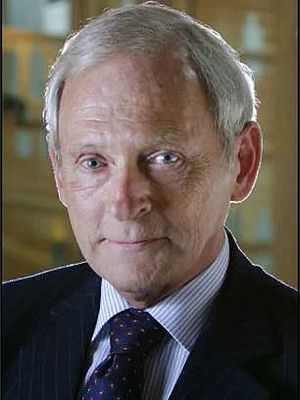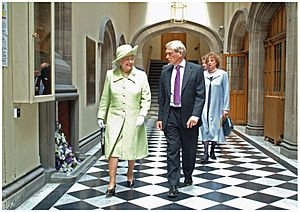George Reid (Scottish politician) facts for kids
Quick facts for kids
Sir George Reid
KT FRSE
|
|||||||||||||||||||||||||
|---|---|---|---|---|---|---|---|---|---|---|---|---|---|---|---|---|---|---|---|---|---|---|---|---|---|

Official portrait, 2003
|
|||||||||||||||||||||||||
| Presiding Officer of the Scottish Parliament | |||||||||||||||||||||||||
| In office 7 May 2003 – 14 May 2007 |
|||||||||||||||||||||||||
| Monarch | Elizabeth II | ||||||||||||||||||||||||
| Deputy |
|
||||||||||||||||||||||||
| Preceded by | David Steel | ||||||||||||||||||||||||
| Succeeded by | Alex Fergusson | ||||||||||||||||||||||||
| Deputy Presiding Officer of the Scottish Parliament | |||||||||||||||||||||||||
| In office 12 May 1999 – 7 May 2003 Serving with Patricia Ferguson (1999–2001) and Murray Tosh (2001–2003)
|
|||||||||||||||||||||||||
| Presiding Officer | David Steel | ||||||||||||||||||||||||
| Preceded by | Office established | ||||||||||||||||||||||||
| Succeeded by | Alasdair Morgan | ||||||||||||||||||||||||
|
|||||||||||||||||||||||||
| Personal details | |||||||||||||||||||||||||
| Born |
George Newlands Reid
4 June 1939 Tullibody, Clackmannanshire, Scotland |
||||||||||||||||||||||||
| Died | 12 August 2025 (aged 86) Denny, Falkirk, Scotland |
||||||||||||||||||||||||
| Political party | Scottish National Party | ||||||||||||||||||||||||
| Alma mater | University of St Andrews Union College |
||||||||||||||||||||||||
Sir George Newlands Reid (4 June 1939 – 12 August 2025) was a Scottish politician and journalist. He was well-known for serving as the Presiding Officer of the Scottish Parliament from 2003 to 2007. He was a member of the Scottish National Party (SNP).
Sir George was a Member of the Scottish Parliament (MSP) for the Mid Scotland and Fife region from 1999 to 2003. Later, he represented the Ochil area from 2003 to 2007. Before joining the Scottish Parliament, he was a Member of Parliament (MP) for Clackmannan and Eastern Stirlingshire from 1974 to 1979.
Contents
Early Life and Education
George Reid was born on 4 June 1939 in Tullibody, near Alloa, Clackmannanshire, Scotland. His father was a company director. He attended Tullibody School and Dollar Academy.
He studied at the University of St Andrews, where he earned a degree in History in 1962. He continued his studies in Switzerland and at Union College in the United States. There, he gained a diploma in international relations, which is about how countries work together.
A Career in Journalism
Before becoming a politician, George Reid had a long career as a journalist. He worked as a broadcast journalist and television producer for major companies like the BBC, Granada Television, and Scottish Television. He also wrote for several newspapers.
He produced over 200 television documentaries. One famous documentary, Contract 736, won an Emmy Award. It was about building the RMS Queen Elizabeth 2 ship.
After his time as a Member of Parliament, he briefly returned to journalism. He presented a show for BBC Scotland. He also produced a very important report by Michael Buerk about the Ethiopian famine of 1984. This report helped inspire the famous Band Aid and Live Aid charity concerts.
His work with the famine report led him to join the International Red Cross and Red Crescent. He worked there for 12 years as Director of Public Affairs. He traveled worldwide to help in conflict and disaster areas, including the 1988 Armenian earthquake.
Political Journey
Starting in Politics
George Reid first became a politician in February 1974. He was elected as a Scottish National Party (SNP) Member of Parliament (MP) for Clackmannan and East Stirlingshire. He won this election and was re-elected later that year. He served as an MP until 1979.
During his time in the UK Parliament, he also worked with international parliamentary groups. These groups helped countries in Europe work together.
In 1995, he became more involved in Scottish politics again. He spoke about why a Scottish Parliament would be good for Scotland. He believed that a Scottish Parliament would help parties like the SNP grow stronger.
Joining the Scottish Parliament
In 1999, when the new Scottish Parliament was established, George Reid was elected as a Member of the Scottish Parliament (MSP). He represented the Mid Scotland and Fife region.
At the very first meeting of the Scottish Parliament, he was elected as a Deputy Presiding Officer. This role is like a vice-chairperson, helping to lead the Parliament's meetings.
Leading the Scottish Parliament (2003–2007)
In the 2003 election, George Reid won the Ochil area seat. After this, his fellow MSPs chose him to be the Presiding Officer of the Scottish Parliament. This is a very important role, similar to a speaker or chairperson in other parliaments. The Presiding Officer makes sure debates are fair and orderly.
Because the Presiding Officer must be fair to all parties, George Reid temporarily stopped being a member of the SNP during his time in this role.
As Presiding Officer, he advised the Queen. He also oversaw the completion of the new Scottish Parliament building at Holyrood. The Parliament moved into this new building in 2004. At the official opening, he gave a speech praising the building's design. He encouraged politicians to be inspired by it.
He also helped create the Scottish Futures Forum. This group helps different political parties think about Scotland's long-term future. He became President of the Royal Commonwealth Society Scotland and a Patron of the Scottish Disability Equality Forum, which helps people with disabilities.
After His Time as Presiding Officer
George Reid decided not to run for re-election at the end of the 2007 Parliamentary term. After leaving the Scottish Parliament, he continued to serve the public. He was chosen to lead a review of how the Northern Ireland Assembly was run. He also worked on international diplomatic missions for the European Union.
In January 2008, he was appointed Lord High Commissioner to the General Assembly of the Church of Scotland. This was a very important ceremonial role, representing the Queen at the Church of Scotland's annual meeting. He held this role for two years.
He also became an Honorary Professor at the University of Glasgow's School of Law. From 2008 to 2011, he advised on the Scottish Ministerial Code, which sets rules for government ministers.
In September 2009, he led a review for the National Trust for Scotland, helping them improve their operations. He was also appointed as Her Majesty's Lord Lieutenant of Clackmannanshire, a local representative of the monarch. From 2010 to 2014, he served as an Electoral Commissioner, helping to oversee elections.
In 2013, he faced a serious health challenge and decided to step down from his roles to focus on his recovery. He made a good recovery.
Passing Away
Sir George Reid passed away on 12 August 2025, at the age of 86. Many people, including the current Presiding Officer of the Scottish Parliament, Alison Johnstone, shared tributes to his life and work.
Awards and Special Recognitions
George Reid received many awards for his work. After helping with relief efforts for the 1988 Armenian earthquake, he was given gold medals from Armenia and the USSR.
During his time as Presiding Officer, he won the Herald newspaper's Scottish Politician of the Year award twice, in 2003 and 2005. He was the first person to win it more than once. In 2013, he received a lifetime achievement award. In 2007, he was made a Free man of Clackmannanshire, his home county.
He also received several honorary doctorates from universities, including the University of St Andrews in 2005, Queen Margaret University in 2006, the University of Edinburgh in 2007, and the University of Stirling in 2008. These are special degrees given to honor his achievements.
In 2012, he was knighted by the Queen for his services to Scottish politics and public life. This meant he could use the title "Sir." In 2015, he became a Fellow of the Royal Society of Edinburgh (FRSE), which is a recognition for experts in Scotland.
On 10 June 2022, he received one of Scotland's highest honors. He was appointed a Knight of the Order of the Thistle (KT) alongside Dame Elish Angiolini.


